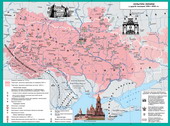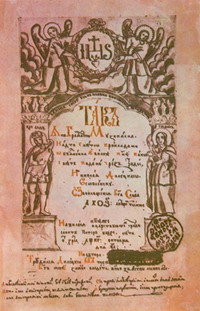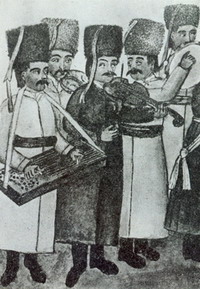CULTURAL DEVELOPMENT OF UKRAINE IN THE SECOND HALF XVII - first half of XVIII century.
FIGURES
Lazarus Baranovych (c. 1620-1693) - famous Ukrainian church, educational, political activist. He studied and later taught at the Kyiv Mohyla Academy, in 1650-1657 he was - its rector. In 1657 the Archbishop of Chernigov and Acting Metropolitan of Kiev. Supporters of independence of the Ukrainian Orthodox Church of Moscow Patriarch.
Daniel Tuptalo (Dimitri Rostov, 1651-1709) - Ukrainian writer encyclopedist and church and educational leader. Born in Kiev region in a family of Cossack captain. Ordained in 1669 under the name of Demetrius, from 1679 - Abbot of monasteries in Ukraine.; From 1702 - the Metropolitan of Rostov. Canonized.
Feofan Prokopovich (1681-1736) - Ukrainian scientist encyclopedist, public and church figure. He left a rich and diverse scientific and literary heritage. He wrote poems in Latin, Polish, Ukrainian, historical works, sermons, philosophical and political treatises, textbooks and more. Education Feofan Prokopovich won in Kiev (graduated Kyiv Mohyla Academy) in Rome. Professor, later rector of the Kyiv Mohyla Academy. But had to leave Ukraine: in 1716 by order of the king went to St. Petersburg. He became one of the closest advisers to the king on church reform (helped eliminate a patriarch and a synod under the control of the king) and public policy. Since 1718 - the bishop of Pskov, in 1721 - Vice-President of the Synod (President - S. Jaworski), from 1724 - Archbishop of Novgorod.
Stefan Jaworski (1658-1722) - famous Ukrainian church statesman, philosopher, writer. He studied at the Kyiv Mohyla College, in Lvov, Lublin, Poznan and free. By order of Peter Jaworski moved to Russia where he became metropolitan of Ryazan and Muroms'kyi and then Exarch and blyustytelem nationwide patriarchal throne. In 1721 was president of the Synod and the protector of Slavic-Greek-Latin Academy.
Samiylo Velichko (1670-1728) - Ukrainian chronicler. He studied at Kyiv Mohyla Academy. Served as clerk in Basil Kochubey, and in 1705-1708 he was - in the General Registry. In late 1708 came to prison at the time of repression against supporters of Peter I. Mazepa. After his release in 1715 he settled in the village. Zhukah in Poltava region, where during 1715-1720 he had written a detailed piece on the history of Ukraine 1648-1700 biennium
John Schyrskyy (? - 1714) - famous Ukrainian painter and engraver. Until 1683 worked in Vilnius, later - in Chernigov and Kiev. In Liubech in Chernihiv restored monastery of St. Antony's Cave (from 1697 - Archimandrite of the monastery), built in 1711 with the support of the church of St. Ivan Mazepa Onuphrius. In 1707-1709 he taught poetics in Chernihiv College.
FEATURES OF CULTURE
development of Ukrainian culture in the second half of XVII - XVIII century the first half. occurred at very complex, sometimes contradictory terms.
- National War in the mid XVII. and revival of the Ukrainian state were instrumental in raising the creative spirit of the Ukrainian people.
- important factor in the development of spiritual life in Ukraine was Ukrainian Hetman cultural policy in support of the Ukrainian Orthodox Church, the national education, typography, art.
However - development of Ukrainian culture spryamuvavsya dismemberment of Ukrainian lands and unequal terms of their development.
- better control of the Ukrainian cultural life - a characteristic of colonial policy of any State, who owned land in Ukraine. For instance, the attack on the tsarist state Ukraine took place simultaneously with the increased pressure in the field of culture.
- heavy blow to the Ukrainian culture was the subordination of the Ukrainian Orthodox Church Moscow Patriarchate (1687).
Another step - imperial government that strengthened the intervention in tsarist state life of Ukraine were all sorts of censorship oppression Ukrainian typography. In particular, the 20's of the XVIII century. implemented strict censorial control of the Synod of the Kiev and Chernihiv researched. It was forbidden to print books in Ukrainian.
- After the battle of Poltava Ukrainian business education came under the strict control of royal government: the king's decree was reduced the number of students of Kyiv-Mohyla Academy (two thousand students left in 1710, only 165 persons); removed from teaching people who, According to Russian military commanders were not sufficiently loyal to the king.
- addition, the tsarist government strongly encouraged the outflow figures of Ukrainian culture in Moscow.
By Peter - is zmanyuvannya elite rice has become violent: high positions gained only with Ukrainian leaders who favored the king and obey him in all liberty.
The highest church dignitaries - Russian Empire were Ukrainian ( Stefan Jaworski, Feofan Prokopovich ).
- was a time when all the episcopal chair in Russia Ukrainian covered.
- in this most tragic was that for high office had to deny his Ukrainian roots.
- not escape oppression in the field of culture and western lands. For example, most colleges on the Right Bank and western Ukraine was under the control of the Jesuits.
- Ukrainian remained only the initial communal and public schools, but they persecuted the Polish magnates.
EDUCATION AND BOOK. Kyiv-Mohyla Academy
- lower levels in education were primary schools. Their number is over 18 centuries. steadily increased.
- the first half of 18 century. lands on the Left Bank Hetman and operated Slobozhanshchina colleges - Chernigov (1700), Kharkov (1726) and Pereyaslavs'kyi (1738).
- By that time Ukrainian colleges were vsestanovymy: they learned not only children of priests, nobles and Cossack, but natives of peasants and townspeople. Number of students in college were significant: for example, in Chernihiv annually 700-800 people attended.
- universities in Ukraine, the main cell science and art during the second half of XVII - XVIII century the first half. remained Kyiv Mohyla Academy.
- grateful memory of the founder entrenched in the name of the college, which in his lifetime became known as the Metropolitan of Kiev-Mohyla.
- As for academy status, it is perceived as the newly created institution contemporaries. Although a formal point of view Academy was recognized in 1658 Hadiach contract.
Support - Ivan Mazepa contributed to the bloom of the school: to 1709 it trained up to 2 thousand students from different regions of Ukraine, as well as Belarus, Russia, Moldova, South countries.
- new phase in the academy linked to the activity Raphael Zaborowski, who became Metropolitan of Kiev in 1731
- During this period of Kyiv Mohyla Academy remained vsestanovym institution.
- Development of Education was in direct relation to publishing . The largest publishing center remained printing Lavra.
- Many books came out in Chernihiv and printing. There were also printing in Lviv, Lutsk, Kremenchug, Univ, Pochaiv.
LITERATURE
feature-theological works
|
Year |
Author |
Name |
Summary of |
|
1655 |
Yoanykiy Halyatovskyi |
"key of knowledge" |
collection of sermons |
|
1676 |
Lazarus Baranovych |
"A new measure of the old faith" |
Answer Jesuit book "Old Faith" |
|
1689 -
1705 |
Tuptalo Dimitri |
Chetyi-Mine |
in four volumes; ordering Lives of the Saints. Actually, the first encyclopedia for the Orthodox world |
|
"Fleece irrigations" |
Collection transfer icon on the wonders of God Chernihiv Trinity Monastery |
Ukrainian chronicles and historical fiction
most famous sights
|
Year |
Author |
Name |
Summary of |
|
1672-1673 biennium |
Theodosius Sofonovych |
"Chronicles of Ancient chronicles" |
In the preface to the work, the author emphasized their desire to trace the early history of Rus' Gentlemen, that is, the Rus-Ukrainian state. The Chronicles of ...", written in Ukrainian, was published only in 1922 |
|
1674 Plant Kiev-Pechersk monastery |
written as researchers believe, saves Lavra Panteleimon Kochanowski |
"Synopsis" |
only historical work that was published at that time. He is destined to the glory of the first textbook on history. The popularity of a work by the fact that the second edition was published in 1678, and another two years pereyzdachy third book. Total "Synopsis" stood about 30 publications. |
Cossack chronicles
phenomenon most famous historical literature of the first half of XVIII century. were Cossack chronicles.
Eyewitness Chronicle
authors believe Roman Romanovsky-shells , military and political figure during ruins.
oldest among large Cossack chronicles. It describes events from 1648 to 1702 piece written in Ukrainian, close to the popular (probably 1702). Distributed in the lists.
sources were various documents, books and records, the testimony of eyewitnesses and contemporary events.
Author
favor of the Liberation War, provides a textbook picture of the causes, though not inclined to idealize the war and its leaders. Saw no perceived union Khmelnitskogo of Islam-III, was depressed victims of severe and desolate ruins of Ukraine dated. Much emphasis and Zaporozhye Cossacks, especially I. sulfur, but his attitude toward the Cossacks are restrained.
Chronicle Gregory Hrabianka
Established in 1710 Gadyach second among large Cossack chronicles. Written in Church Slavonic language. Of the events from ancient times to 1709 - Ivan Mazepa's defeat and the election of Ivan Skoropadskyi. Main attention is paid to the course of the National Liberation War led by Bohdan Khmelnytsky. Author, creating a record, prostudiyuvav large number of documents and various historical works of his contemporaries and predecessors, relied also on folk stories. Perhaps this explains the popularity of extreme Hrab'yankovoyi books, as evidenced by the dozens of lists, in which, in fact, be distributed record.
Chronicle Samiylo Wieliczka
Work
Wieliczka is the most prominent phenomenon of the Cossack chronicles. It chronicles - book Ukrainian. Chronicle consisted of two parts: the description of events from 1648 to 1660 and from 1660 to 1700 came to us damaged, and no end of gaps, especially in the first part. Manuscript Samiylo Wieliczka accompanied by ten portraits hetmans contains many documents poetic texts.
UKRAINIAN BAROQUE ARCHITECTURE
Ukrainian architecture of the second half of XVII - XVIII century. defined as the Baroque architecture .
word "Baroque" from the Italian language means bizarre, weird . It is called artistic style that prevailed in Europe from the late XVI and almost to the end of XVIII century.
For Baroque art is characterized by extreme attention to the form. In the literature, this feature has appeared in a variety of genres - even to such verbal exercises, as figured poems and pyshnomovnosti: and in the construction of complex sentences wordy, and applying fancy unexpected comparisons, the accumulation of images, coupled with ancient biblical mythology and more. In the XVII century. baroque was even writing a letter (telling in this respect are the signatures of Ukrainian Hetman and clerk). Baroque buildings are typical accumulation luxurious decorations, highlighted by decorative, grandiosity. On the Ukrainian lands Baroque style was most vividly in the works of architects J. Schadel, S. Kovnir, I.Hryhorovycha-Barsky, B. Rastrelli, B. Meretin, painters Kondzelevicha J., I. Rutkovych, sculptor I. Pinsel, the music of Baroque art represented by names such as M. Berezovsky, Bortnyanskyi, A. Wedel, in literature - Velichkovskyj G. Hornbeam Kostyanko, S. Velichko.
- For architectural structures that have emerged in these times in Hetmanate and Sloboda Ukraine, researchers posluhovuyutsya term Cossack Baroque.
- largest Ukrainian baroque building was built during the reign of Hetman Ivan Mazepa .
Hetman - expense of about a dozen churches built.
- In Kiev, especially, Mazepa supervised construction Brotherhood Church of the Epiphany, St. Nicholas Cathedral Church of All Saints over economic Gate of Kiev-Pechersk Lavra (1696-1698 biennium).
- For Baroque features Mazepa acquired long ago, the Kievan Rus, buildings - Sophia and Michael's churches that were restored at the expense of the hetman.
- the Baroque style and Assumption Cathedral and Trinity Gate Church Caves . Actually, in such a baroque style, these temples are now preserved.
Starodub - expense of Colonel Michael Myklashevska was built several churches on the way to Kyiv from Starodub: in Novgorod-Seversky, deaf, and Vydubitskim monastery in Kiev - Murovanye refectory of Transfiguration Church and St. George's Cathedral (1696-1701 biennium)
- Transfiguration Church in Mhar (1732) built at the expense of Hetman Danylo Apostol .
- true masterpieces of world architecture in the Cossack Baroque style buildings are also Savior Cathedral near the monastery Mgarsk Lubny (1684-1692 biennium), Exaltation of the Cross Church in Poltava (1709), Pokrovsky in Kharkov (1689) Transfiguration in Izium (1684), Catherine church in Chernigov (1716).
FINE ARTS
Graphics
with vertices baroque book design end of XVII - beginning of XVIII century. Related Three great in the history of Ukrainian art figures - Alexander Tarasevich and Leontius and John Schyrskoho.
Peru - these three artists is a huge number of first-class in terms of technology and Baroque Drawing on the type of thinking pattern of graphic works, full of symbolic meaning and the allegorical lush theatricality.
Painting
Unlike graphics, iconography acquired Ukrainian baroque strymanishe.
Strengthening - a painting in the beginning of treatment lykiv saints associated with the penetration of Western elements in the icon painting tradition, in more senses of creativity and Volyn Galician artists.
- Among them in the last quarter of XVII century. such a distinguished figure in a painting cell Zhovkva as John Rutkovych . In Volhynia at the same time in a similar manner worked Job Kondzelevych with Zhovkva, Bialystok monk monastery near Lutsk.
During - XVII - XVIII century. widespread in Ukraine has taken Virgin icon. Pattern Protection, quite a few.
- the bottom of such icons presented a realistic picture Cossack representatives, ataman, Hetman.
- example, preserved Virgin icon depicting Mary Bogdan Khmelnitsky.
- Extremely popular throughout Ukraine enjoyed the image Cossack Mom. During the XVIII century. it can be seen in every house Ukrainian.
- Kazakov painted with oil paints on canvas, walls, doors, windows, tiles, boxes, containers and even hives, considering the symbolic image of Mamaia talisman.
- preserved many variations of folk painting.
- researchers are unanimous in thinking that Cossack Mamay - the embodiment of the main features of Ukrainian origin.
 English
English






















